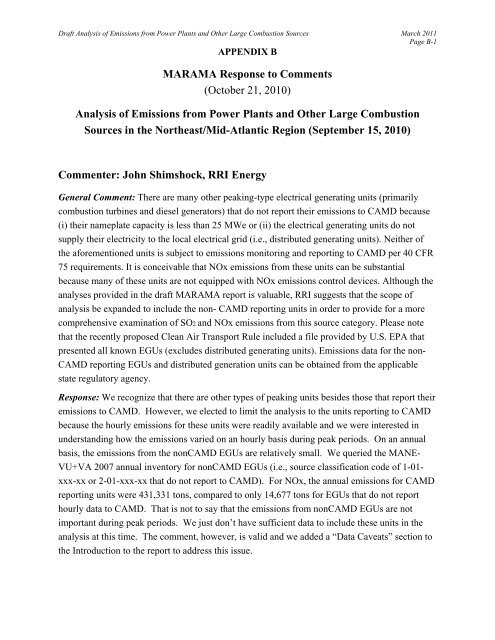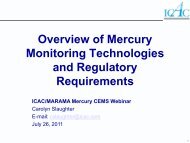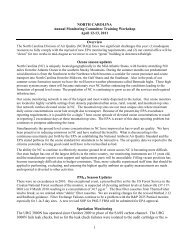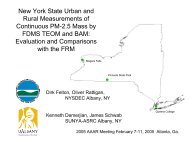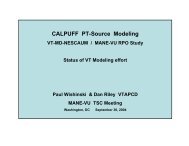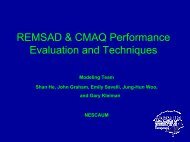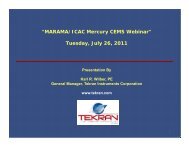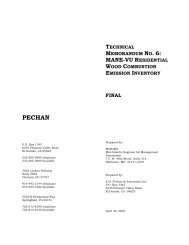Analysis of 2007 Emissions from Power Plants and Other ... - MARAMA
Analysis of 2007 Emissions from Power Plants and Other ... - MARAMA
Analysis of 2007 Emissions from Power Plants and Other ... - MARAMA
Create successful ePaper yourself
Turn your PDF publications into a flip-book with our unique Google optimized e-Paper software.
Draft <strong>Analysis</strong> <strong>of</strong> <strong>Emissions</strong> <strong>from</strong> <strong>Power</strong> <strong>Plants</strong> <strong>and</strong> <strong>Other</strong> Large Combustion Sources March 2011Page B-1APPENDIX B<strong>MARAMA</strong> Response to Comments(October 21, 2010)<strong>Analysis</strong> <strong>of</strong> <strong>Emissions</strong> <strong>from</strong> <strong>Power</strong> <strong>Plants</strong> <strong>and</strong> <strong>Other</strong> Large CombustionSources in the Northeast/Mid-Atlantic Region (September 15, 2010)Commenter: John Shimshock, RRI EnergyGeneral Comment: There are many other peaking-type electrical generating units (primarilycombustion turbines <strong>and</strong> diesel generators) that do not report their emissions to CAMD because(i) their nameplate capacity is less than 25 MWe or (ii) the electrical generating units do notsupply their electricity to the local electrical grid (i.e., distributed generating units). Neither <strong>of</strong>the aforementioned units is subject to emissions monitoring <strong>and</strong> reporting to CAMD per 40 CFR75 requirements. It is conceivable that NOx emissions <strong>from</strong> these units can be substantialbecause many <strong>of</strong> these units are not equipped with NOx emissions control devices. Although theanalyses provided in the draft <strong>MARAMA</strong> report is valuable, RRI suggests that the scope <strong>of</strong>analysis be exp<strong>and</strong>ed to include the non- CAMD reporting units in order to provide for a morecomprehensive examination <strong>of</strong> SO2 <strong>and</strong> NOx emissions <strong>from</strong> this source category. Please notethat the recently proposed Clean Air Transport Rule included a file provided by U.S. EPA thatpresented all known EGUs (excludes distributed generating units). <strong>Emissions</strong> data for the non-CAMD reporting EGUs <strong>and</strong> distributed generation units can be obtained <strong>from</strong> the applicablestate regulatory agency.Response: We recognize that there are other types <strong>of</strong> peaking units besides those that report theiremissions to CAMD. However, we elected to limit the analysis to the units reporting to CAMDbecause the hourly emissions for these units were readily available <strong>and</strong> we were interested inunderst<strong>and</strong>ing how the emissions varied on an hourly basis during peak periods. On an annualbasis, the emissions <strong>from</strong> the nonCAMD EGUs are relatively small. We queried the MANE-VU+VA <strong>2007</strong> annual inventory for nonCAMD EGUs (i.e., source classification code <strong>of</strong> 1-01-xxx-xx or 2-01-xxx-xx that do not report to CAMD). For NOx, the annual emissions for CAMDreporting units were 431,331 tons, compared to only 14,677 tons for EGUs that do not reporthourly data to CAMD. That is not to say that the emissions <strong>from</strong> nonCAMD EGUs are notimportant during peak periods. We just don’t have sufficient data to include these units in theanalysis at this time. The comment, however, is valid <strong>and</strong> we added a “Data Caveats” section tothe Introduction to the report to address this issue.


